East Germany - 10 things you never knew about the GDR

October 7th is the anniversary of the GDR's formation. Here are 10 fascinating nuggets of trivia to impress your friends!
At the end of the Second World War, Germany was split into four militarily occupied zones: American, British and French in the west, and Soviet in the east. The original aim was to work together to help reconstruct Germany, but also to ensure that it could never again become a threat to world peace.
But the Cold War soon got in the way of this. The German Democratic Republic (GDR) was formed by the Soviets on October 7th 1949 in the east, after the other three zones had already combined to form the Federal Republic of Germany a few months earlier.
From 1949 until the fall of the Berlin Wall in November 1989, these two states remained entirely separate, developing very different identities. After over 25 years of reunification, the GDR is a distant memory for many, but it still influences modern Germany.
Here are some interesting facts about this very unique state:
1. The GDR had the highest concentration of allotments and dachas in the world
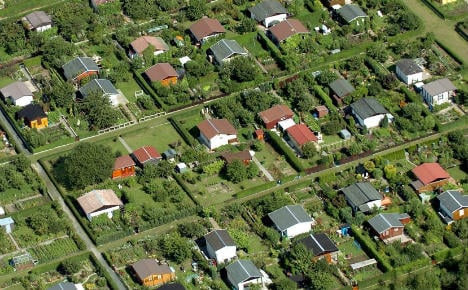 Dachas near Dresden. Photo: DPA
Dachas near Dresden. Photo: DPA
With ‘stay-cations’ replacing vacations for many who are feeling the effects of the slow economic growth, perhaps we should take a lesson from the former East Germans.
Many of them lived in pokey, purpose-built apartments in the middle of the city, so it’s no wonder that they liked to escape on the weekend to their own little green spaces. Totalling 2.6 million weekend get-aways and 855,000 allotments, most people had access to one - or else went camping!
The dacha - or ‘Datsche’ - was usually rustic and modest, but still provided the perfect place for a bit of R&R.
2. One in 90 East Germans worked unofficially for the secret police
The people of the GDR were some of the most spied on in the world. Much of the information gained by the Stasi - the Staatssicherheit (secret police) - came from inoffizielle Mitarbeiter (informal collaborators), who were otherwise normal citizens.
Estimates of their number vary, but the BStU (Commission for Stasi Records) accepts that there were around 189,000 informal collaborators in 1989, in other words one for every 90 citizens. And that didn't even include the full-time staff! Numbers also varied throughout the GDR's 40-year lifespan, rising during times of political crisis.
But the trustworthiness of the BStU itself was questioned when WikiLeaks revealed in 2007 that it employed at least 79 former Stasi members.
3. Jeans were taboo until the 1970s, when the state finally ‘cottoned’ on
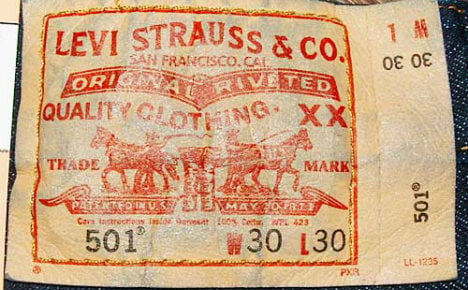 Levi Strauss jeans label - German businessman Levi Strauss moved to America and founded the company in 1853. Photo: Ludovic Glucksman
Levi Strauss jeans label - German businessman Levi Strauss moved to America and founded the company in 1853. Photo: Ludovic Glucksman
The East German government kept a close eye on the growth in the popularity of jeans in the early years. Dance halls banned the so-called "riveted pants", and children wearing them at school would be sent home! The state saw them as an expression of western capitalism, and of rebellion.
Despite being a political statement, many would go to extraordinary measures to get their hands on a pair. They would either try to smuggle them in from the West through the post, or pay extortionate prices on the black market.
Sensing a lost battle, the GDR started to produce their own jeans from 1974. These never really compared with western counterparts, as they were made from partially synthetic materials due to cotton shortages.
So, in 1978, in an attempt to gain popularity, the state imported a million pairs of Levi’s from America. These were sold in selected universities and companies, and even in the Ministry of State Security - to the Stasi!
4. Berlin wasn’t the only place split by a concrete wall
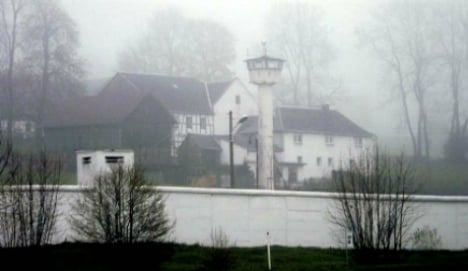 The wall through Mödlareuth. Photo: Von Angelo D Alterio
The wall through Mödlareuth. Photo: Von Angelo D Alterio
We’re all familiar with the pictures of the infamous wall that split East and West Berlin, but it wasn’t the only community in Germany split down the middle by concrete. Mödlareuth am Tannbach was a tiny village of around 50 people, situated right on the border of Thuringia and Bavaria.
As this was also the border between the American and Soviet zones of Germany, the American soldiers nicknamed it ‘Little Berlin’. From the 1960s the fence through the middle became a solid wall and remained so until 1989.
5. You could easily wait 15 years for the opportunity to buy a car
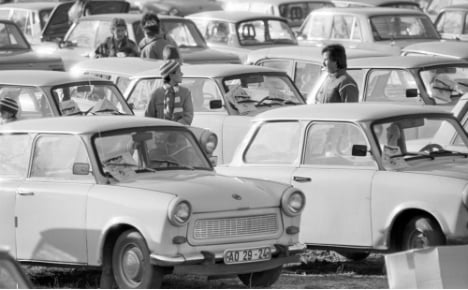 A car park full of Trabants in a car park in West German Lübeck just a few days after the Wall fell. Photo: DPA
A car park full of Trabants in a car park in West German Lübeck just a few days after the Wall fell. Photo: DPA
Now a bit of a cult car in Berlin and beyond, The Trabant, affectionately known as the ‘Trabi’, was a model of car made in the GDR. This is a great example of 'Ostalgie' - nostalgia for the former state - that emerged after 1990.
Essentially little more than a lawn-mower with four doors, these cars were built extremely cheaply, and were renowned for being slow, noisy, and extremely polluting. The outside of the car was actually made out of plastic from recycled materials. And they could do 0-60 mph in... 21 seconds.
And yet, East Germans were determined to have one, despite production being way behind target.
"Everyone tried to afford a Trabant during the East German times. You had to have yourself put on a list and you had to wait for the car between 11 and 15 years," Johannes Drexler, a Trabant tour guide in Berlin, told Deutsche Welle.
The appeal of the Trabi doesn't show signs of slowing either - you can take a ‘Trabi Safari’ around Berlin if you feel that the open-top bus is a bit last year!
6. Behind in many things, the GDR led on recycling
It wasn’t only the car shells which were made from recycled materials, but also jeans, and many other products. Children collected bottles, metal, paper, cans, even camera film, and they could earn some money from the debris in a collection centre.
When the government shut down funding in 1990, the centres' intake shrunk by 90%, decimating the success of the former communist system. For a state so backward by 1990, this was just one way in which they seemed quite modern!
7. Communist brands are still available in your local store!
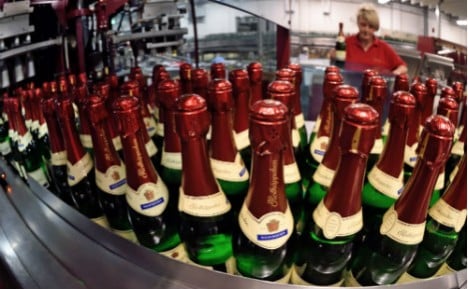 Rotkäppchen Winery in Freyburg, Saxony-Anhalt. Photo: DPA
Rotkäppchen Winery in Freyburg, Saxony-Anhalt. Photo: DPA
Even after a quarter of a century, some ex-communist brands remain on the shelves of German supermarkets! Another good example of ‘Ostalgie’, certain food brands have maintained their popularity even against the flood of capitalist competition after the fall of the Wall.
The most well-known examples include ‘Rotkäppchen’ (Red Riding Hood), which is a brand of sparkling wine whose success continued after 1989 to such an extent that they were able to buy the West German Mumm winery.
Others include fizzy drink ‘Vita Cola’, first produced in 1957, that can be bought in your local Aldi, and Spreewald pickles, which are geographically protected by the EU as a traditional speciality.
8. GDR mums donated 200,000 litres of breast milk to milk banks in 1989
Now few and far between in Germany, the East still had 60 mother's milk banks in 1989. The first milk banks had been introduced in Germany after the First World War, to supply breast-milk for children who would not otherwise have access to it.
From 1952, any GDR city with a population over 50,000 had to have a bank by law. Donors were given extra food coupons as payment. By 1958, the East had 62 milk banks, whereas the West had only 24.
With premature births being more likely to survive, demand was increasing. However, other women's breast milk was losing popularity in the West as people feared the risk of disease. This concern in the West, although true to a certain extent, was partly fuelled by formula-milk manufacturer's advertising campaigns.
By 1989, over 200,000 litres were being donated annually in the GDR, which was enough to fill the demand without artificial formula-milk. After reunification, they lost government support and all of them were shut down by 1990. But there has been a resurgence more recently and milk banks are back on the rise.
9. The state introduced quotas and financial support to get women to work
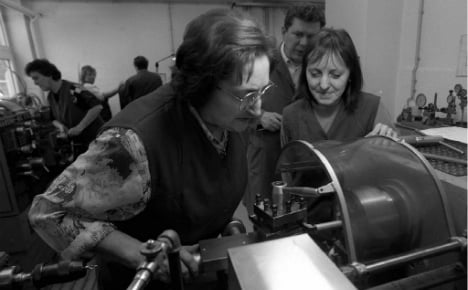 An East German woman trains to use a lathe. Photo: DPA
An East German woman trains to use a lathe. Photo: DPA
Although the concept of ‘feminism’ that took over the West in the 1960s and 1970s would have been pretty foreign to East German women, there was a feminist movement of sorts.
Engineered by the government along the lines of ‘Marxist feminism’, a comprehensive system was introduced to help women into work. Seeing the patriarchy as a result of capitalism, they introduced quotas for working women in industry, as well as introducing comprehensive laws to protect working mothers, and to supply childcare.
It is estimated that in 1990 around 90% of women were employed in East Germany, compared to only 55% in the former Federal Republic. Even today, as the federal statistics office Destatis recently calculated, the gender pay gap is still significantly different in the two former states: around 8% in the former communist states compared to 23% in the West.
10. There is a hotel in Berlin called the ‘Ostel’, which is decorated with original GDR furniture
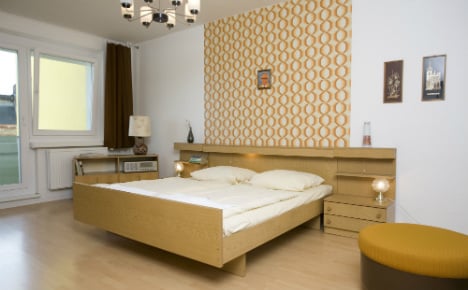 A room in the Ostel, complete with Honnecker icon above the bed. Photo: Daniel Helbig
A room in the Ostel, complete with Honnecker icon above the bed. Photo: Daniel Helbig
Not satisfied with a meal in one of the many ‘Ostalgie’ restaurants or a drive in a ‘Trabi’? Then go one step further and stay in an 'Ostalgie’ hotel. Based in one of the former East German ‘Plattenbauten’ (a pre-fabricated building), this place will teleport you back 40 years.
Apart from the mattresses and sheets, everything in this hotel is authentic. And, of course, each room has a portrait of former GDR leader Erich Honecker to watch over you!
By Alexander Johnstone
Comments
See Also
At the end of the Second World War, Germany was split into four militarily occupied zones: American, British and French in the west, and Soviet in the east. The original aim was to work together to help reconstruct Germany, but also to ensure that it could never again become a threat to world peace.
But the Cold War soon got in the way of this. The German Democratic Republic (GDR) was formed by the Soviets on October 7th 1949 in the east, after the other three zones had already combined to form the Federal Republic of Germany a few months earlier.
From 1949 until the fall of the Berlin Wall in November 1989, these two states remained entirely separate, developing very different identities. After over 25 years of reunification, the GDR is a distant memory for many, but it still influences modern Germany.
Here are some interesting facts about this very unique state:
1. The GDR had the highest concentration of allotments and dachas in the world
 Dachas near Dresden. Photo: DPA
Dachas near Dresden. Photo: DPA
With ‘stay-cations’ replacing vacations for many who are feeling the effects of the slow economic growth, perhaps we should take a lesson from the former East Germans.
Many of them lived in pokey, purpose-built apartments in the middle of the city, so it’s no wonder that they liked to escape on the weekend to their own little green spaces. Totalling 2.6 million weekend get-aways and 855,000 allotments, most people had access to one - or else went camping!
The dacha - or ‘Datsche’ - was usually rustic and modest, but still provided the perfect place for a bit of R&R.
2. One in 90 East Germans worked unofficially for the secret police
The people of the GDR were some of the most spied on in the world. Much of the information gained by the Stasi - the Staatssicherheit (secret police) - came from inoffizielle Mitarbeiter (informal collaborators), who were otherwise normal citizens.
Estimates of their number vary, but the BStU (Commission for Stasi Records) accepts that there were around 189,000 informal collaborators in 1989, in other words one for every 90 citizens. And that didn't even include the full-time staff! Numbers also varied throughout the GDR's 40-year lifespan, rising during times of political crisis.
But the trustworthiness of the BStU itself was questioned when WikiLeaks revealed in 2007 that it employed at least 79 former Stasi members.
3. Jeans were taboo until the 1970s, when the state finally ‘cottoned’ on
 Levi Strauss jeans label - German businessman Levi Strauss moved to America and founded the company in 1853. Photo: Ludovic Glucksman
Levi Strauss jeans label - German businessman Levi Strauss moved to America and founded the company in 1853. Photo: Ludovic Glucksman
The East German government kept a close eye on the growth in the popularity of jeans in the early years. Dance halls banned the so-called "riveted pants", and children wearing them at school would be sent home! The state saw them as an expression of western capitalism, and of rebellion.
Despite being a political statement, many would go to extraordinary measures to get their hands on a pair. They would either try to smuggle them in from the West through the post, or pay extortionate prices on the black market.
Sensing a lost battle, the GDR started to produce their own jeans from 1974. These never really compared with western counterparts, as they were made from partially synthetic materials due to cotton shortages.
So, in 1978, in an attempt to gain popularity, the state imported a million pairs of Levi’s from America. These were sold in selected universities and companies, and even in the Ministry of State Security - to the Stasi!
4. Berlin wasn’t the only place split by a concrete wall
 The wall through Mödlareuth. Photo: Von Angelo D Alterio
The wall through Mödlareuth. Photo: Von Angelo D Alterio
We’re all familiar with the pictures of the infamous wall that split East and West Berlin, but it wasn’t the only community in Germany split down the middle by concrete. Mödlareuth am Tannbach was a tiny village of around 50 people, situated right on the border of Thuringia and Bavaria.
As this was also the border between the American and Soviet zones of Germany, the American soldiers nicknamed it ‘Little Berlin’. From the 1960s the fence through the middle became a solid wall and remained so until 1989.
5. You could easily wait 15 years for the opportunity to buy a car
 A car park full of Trabants in a car park in West German Lübeck just a few days after the Wall fell. Photo: DPA
A car park full of Trabants in a car park in West German Lübeck just a few days after the Wall fell. Photo: DPA
Now a bit of a cult car in Berlin and beyond, The Trabant, affectionately known as the ‘Trabi’, was a model of car made in the GDR. This is a great example of 'Ostalgie' - nostalgia for the former state - that emerged after 1990.
Essentially little more than a lawn-mower with four doors, these cars were built extremely cheaply, and were renowned for being slow, noisy, and extremely polluting. The outside of the car was actually made out of plastic from recycled materials. And they could do 0-60 mph in... 21 seconds.
And yet, East Germans were determined to have one, despite production being way behind target.
"Everyone tried to afford a Trabant during the East German times. You had to have yourself put on a list and you had to wait for the car between 11 and 15 years," Johannes Drexler, a Trabant tour guide in Berlin, told Deutsche Welle.
The appeal of the Trabi doesn't show signs of slowing either - you can take a ‘Trabi Safari’ around Berlin if you feel that the open-top bus is a bit last year!
6. Behind in many things, the GDR led on recycling
It wasn’t only the car shells which were made from recycled materials, but also jeans, and many other products. Children collected bottles, metal, paper, cans, even camera film, and they could earn some money from the debris in a collection centre.
When the government shut down funding in 1990, the centres' intake shrunk by 90%, decimating the success of the former communist system. For a state so backward by 1990, this was just one way in which they seemed quite modern!
7. Communist brands are still available in your local store!
 Rotkäppchen Winery in Freyburg, Saxony-Anhalt. Photo: DPA
Rotkäppchen Winery in Freyburg, Saxony-Anhalt. Photo: DPA
Even after a quarter of a century, some ex-communist brands remain on the shelves of German supermarkets! Another good example of ‘Ostalgie’, certain food brands have maintained their popularity even against the flood of capitalist competition after the fall of the Wall.
The most well-known examples include ‘Rotkäppchen’ (Red Riding Hood), which is a brand of sparkling wine whose success continued after 1989 to such an extent that they were able to buy the West German Mumm winery.
Others include fizzy drink ‘Vita Cola’, first produced in 1957, that can be bought in your local Aldi, and Spreewald pickles, which are geographically protected by the EU as a traditional speciality.
8. GDR mums donated 200,000 litres of breast milk to milk banks in 1989
Now few and far between in Germany, the East still had 60 mother's milk banks in 1989. The first milk banks had been introduced in Germany after the First World War, to supply breast-milk for children who would not otherwise have access to it.
From 1952, any GDR city with a population over 50,000 had to have a bank by law. Donors were given extra food coupons as payment. By 1958, the East had 62 milk banks, whereas the West had only 24.
With premature births being more likely to survive, demand was increasing. However, other women's breast milk was losing popularity in the West as people feared the risk of disease. This concern in the West, although true to a certain extent, was partly fuelled by formula-milk manufacturer's advertising campaigns.
By 1989, over 200,000 litres were being donated annually in the GDR, which was enough to fill the demand without artificial formula-milk. After reunification, they lost government support and all of them were shut down by 1990. But there has been a resurgence more recently and milk banks are back on the rise.
9. The state introduced quotas and financial support to get women to work
 An East German woman trains to use a lathe. Photo: DPA
An East German woman trains to use a lathe. Photo: DPA
Although the concept of ‘feminism’ that took over the West in the 1960s and 1970s would have been pretty foreign to East German women, there was a feminist movement of sorts.
Engineered by the government along the lines of ‘Marxist feminism’, a comprehensive system was introduced to help women into work. Seeing the patriarchy as a result of capitalism, they introduced quotas for working women in industry, as well as introducing comprehensive laws to protect working mothers, and to supply childcare.
It is estimated that in 1990 around 90% of women were employed in East Germany, compared to only 55% in the former Federal Republic. Even today, as the federal statistics office Destatis recently calculated, the gender pay gap is still significantly different in the two former states: around 8% in the former communist states compared to 23% in the West.
10. There is a hotel in Berlin called the ‘Ostel’, which is decorated with original GDR furniture
 A room in the Ostel, complete with Honnecker icon above the bed. Photo: Daniel Helbig
A room in the Ostel, complete with Honnecker icon above the bed. Photo: Daniel Helbig
Not satisfied with a meal in one of the many ‘Ostalgie’ restaurants or a drive in a ‘Trabi’? Then go one step further and stay in an 'Ostalgie’ hotel. Based in one of the former East German ‘Plattenbauten’ (a pre-fabricated building), this place will teleport you back 40 years.
Apart from the mattresses and sheets, everything in this hotel is authentic. And, of course, each room has a portrait of former GDR leader Erich Honecker to watch over you!
By Alexander Johnstone
Join the conversation in our comments section below. Share your own views and experience and if you have a question or suggestion for our journalists then email us at [email protected].
Please keep comments civil, constructive and on topic – and make sure to read our terms of use before getting involved.
Please log in here to leave a comment.